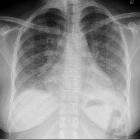TORCH

Infant with
TORCH infection. AP radiograph of the lower extremities shows fraying of the bilateral femoral metaphyses which have alternating radiolucent and radiodense stripes (celery stalking).The diagnosis was congenital rubella osteomyelitis.

Infant with
TORCH infection. AP radiograph of the knee shows shows fraying of the femoral metaphysis which has alternating radiolucent and radiodense stripes (celery stalking).The diagnosis was congenital rubella osteomyelitis.

Congenital
cytomegalovirus infection • Congenital cytomegalovirus - Ganzer Fall bei Radiopaedia

Congenital
cytomegalovirus infection • Congenital cytomegalovirus infection - Ganzer Fall bei Radiopaedia

Congenital
infections (mnemonic) • Intrauterine TORCH infection - Ganzer Fall bei Radiopaedia

Magnetic
resonance imaging patterns of paediatric brain infections: a pictorial review based on the Western Australian experience. T2 hyperintensity in supratentorial white matter—with neuronal migration abnormality (Pattern 4A). Case 1: 11-week-old infant with bilateral sensorineural hearing loss on newborn testing. Guthrie test was positive for CMV. T2-weighted imaging (a–c) demonstrated polymicrogyria with diffuse white matter hyperintensity and cystic change in the left anterior temporal pole. Clinical notes at 14 months of age indicated developmental delay. Case 2: 4-month-old infant with microcephaly, developmental delay and hypertonia under investigation. Guthrie test was positive for CMV. T2-weighted imaging (d) demonstrated polymicrogyria with diffuse white matter hyperintensity and subtle periventricular calcifications (arrows)

Magnetic
resonance imaging patterns of paediatric brain infections: a pictorial review based on the Western Australian experience. T2 hyperintensity in supratentorial white matter—without neuronal migration abnormality (Pattern 4B). Case 1: 2-year-old child with congenital left sensorineural hearing loss. Guthrie test was positive for CMV. T2-weighted imaging (a, b) demonstrated cystic change at the right anterior temporal pole, with bilateral parietal and periventricular white matter hyperintensity. Case 2: 2-year-old child with developmental delay. Guthrie test was positive for CMV. T2-weighted imaging (c, d) demonstrated cystic change at the right anterior temporal pole, with bilateral peritrigonal white matter hyperintensity
The group of the most common congenital infections are referred to by the mnemonic TORCH or STORCH. They usually cause mild maternal morbidity but are related to serious fetal consequences .
In cases where no serological, microbiological or immunological evidence of infection can be identified the term pseudo-TORCH has been used .
Mnemonic
- T: toxoplasmosis
- O: other (e.g. syphilis, varicella-zoster, parvovirus B19)
- R: rubella
- C: cytomegalovirus (CMV) - most common
- H: herpes simplex virus (HSV)
There is a variation of this mnemonic that includes in utero syphilis infection:
- S: syphilis
- T: toxoplasmosis
- O: other (e.g. varicella-zoster, parvovirus B19)
- R: rubella
- C: cytomegalovirus (CMV) - most common
- H: herpes simplex virus (HSV)
Siehe auch:
- intrakranielle Verkalkungen
- in utero infection
- Toxoplasmose
- Zytomegalievirus
- Röteln
- vertically transmitted infection
und weiter:

 Assoziationen und Differentialdiagnosen zu TORCH:
Assoziationen und Differentialdiagnosen zu TORCH:


